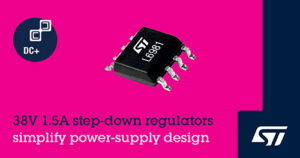STMicroelectronics is offering L6981 synchronous step-down regulators, extending the family of high-efficiency converters that simplify power-supply design by integrating power elements, feedback circuitry, and safety features on-chip.
 Rated to deliver up to 1.5A, with 90 percent typical efficiency at full load, the L6981 converters are available in two variants optimized for light-load efficiency and noise performance.
Rated to deliver up to 1.5A, with 90 percent typical efficiency at full load, the L6981 converters are available in two variants optimized for light-load efficiency and noise performance.
The L6981C for low-current operation uses pulse skipping to maximize efficiency at light loads extending the runtime of battery-powered devices. The L6981N prioritizes low noise by operating permanently in PWM (pulse-width modulation) mode at constant switching frequency and minimizing voltage ripple at light loads.
Both variants can accept an input voltage from 3.5 to 38V, making them well suited to use in 24V industrial bus-powered applications, 12 and 24V battery-powered equipment, HVAC power supplies, decentralized intelligent nodes, smart sensors, and always-on applications. The output voltage can be adjusted from 0.85V up to the input-voltage value using external resistors.
Integrated features include high and low-side NMOS power transistors, feedback-loop compensation, over-voltage protection, and thermal protection. There is also soft-start circuitry that limits inrush current and ensures a constant output-voltage slope.
An Enable pin is provided, which permits power-up/power-down sequencing and allows a synchronizing clock signal to be applied to the L6981N low-noise converters. The L6981 is included in ST’s 10-year longevity program that ensures long-term component supply.
The STEVAL-L6981CDR evaluation board for the low-current converter and STEVAL-L6981NDR for the low-noise version are available to help designers accelerate device selection in power-supply development.
Filed Under: Components, News


Questions related to this article?
👉Ask and discuss on EDAboard.com and Electro-Tech-Online.com forums.
Tell Us What You Think!!
You must be logged in to post a comment.